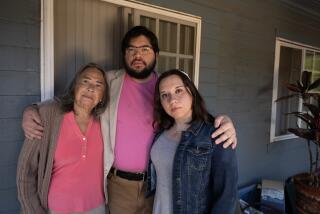Neighborhood Parade Marks Victory Over Violence
- Share via
SANTA ANA — Declaring victory against crime in their neighborhood, residents of 3rd and Olive streets paraded through their neighborhood Saturday, gleefully celebrating an end to the violence that once plagued their community.
The parade marked three years of coordinated efforts among the Police Department, community activists and residents to rid the neighborhood of one of the city’s most violent gangs.
Residents said drive-by shootings used to be commonplace, along with drug dealing and robberies.
Elvira Hernandez said she would never let her young children outside to play after 3 p.m. By mid-afternoon, the gangsters would show up, hang out, sell drugs. By nightfall, guns would blaze, bullets would fly.
Today, her children play soccer in the afternoon at the park down the street, walk to their tutoring lessons and play in their frontyard.
After years of violence, Hernandez said the fear is gone.
“I hated going out,” said Hernandez, as she walked the parade route from 2nd to Olive, and then down 3rd to Flower Street Park. “It was terrifying to live here.”
Hernandez, who has lived in the neighborhood 20 years, said she had never considered organizing the residents to combat crime--she simply accepted it as a fact of life.
But two years ago, she was coaxed into a neighborhood meeting and has tried not to miss one since.
Dozens of residents meet monthly to keep tabs on neighborhood problems and try to find solutions, she said.
Indeed, that kind of involvement has made an impact, said Police Lt. Bill Tegeler.
Police also have done their part in reducing crime.
Santa Ana police were part of a multi-agency task force that arrested 117 gang members and others in the area during a two-day raid in September 1994, Tegeler said. To date, he said, there have been 101 convictions of those arrested.
Crime in the area has decreased 75% since Operation Roundup began in 1994, said Tegeler. In the first six months of 1993, the year before the task force was formed, 20 calls of shots fired were reported. There have been none the first six months of this year. Narcotics-related reports have decreased from 38 in the first six months of 1993 to three so far this year.
The effort has also involved the city Parks Department, which tore down some trees on Third Street that residents said drug dealers were using to hide them. The city’s Public Works Department has filled potholes, increased lighting and fixed the haggard sidewalks.
But it will be up to the residents to keep the criminal element out, all agree.
“This is the best example of community policing and crime solving,” said Tegeler. “But it’s the neighbors that have taken back the streets and the park. They have literally turned this neighborhood around.”
Even police critics like 21-year-old Ralph Moldonaro recognize that the neighborhood has changed for the better. Still, Moldonaro said, police are sometimes overzealous, arresting people who are not gang members. “They’ve done a lot of sweeps and took a lot of people that shouldn’t have been taken,” he said.
Yet, normalcy seems to be returning to this neighborhood.
Albert Thomas, deacon at the Starlight Baptist Church on 3rd Street, said he is seeing more parishioners venture in after dark--something rarely done in the past.
Noel Hermoso, remembers the bullets that ripped through his house during one of the many shootouts. Times have changed dramatically, he said.
“This used to be a war zone,” he said. “Our neighborhood has changed 90%.”
More to Read
Sign up for Essential California
The most important California stories and recommendations in your inbox every morning.
You may occasionally receive promotional content from the Los Angeles Times.










